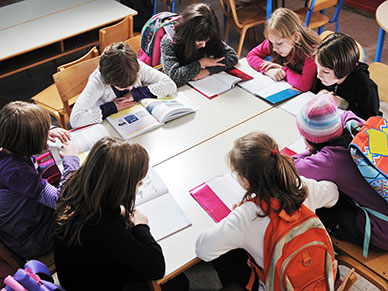
by Georgia Center for Opportunity | Mar 29, 2017
Education savings accounts could help Georgia lawmakers ease overcrowding in public schools, an ongoing challenge for some school districts. Legislators are considering bills that would allow students to use an account to choose how and where they learn, modeled after the accounts in Arizona, Florida, Mississippi, Tennessee, and Nevada.
Under the proposed legislation, and as described on this blog, the state deposits a portion of a child’s funds from the state formula into a private account that parents use to buy educational products and services for their children. Parents can choose different learning options like online classes, personal tutors, and private school tuition simultaneously, customizing a child’s education to meet their needs.
Some Georgia parents have complained of surging enrollment in public schools in recent years. Between 2014 and 2016, Georgia public school enrollment increased 7 percent or 117,000 students, according to state and federal sources. Decatur’s increases have been dramatic: District schools experienced a 123 percent increase over the past decade. Recent reports of overcrowding have also come from Horry County, Dalton, and DeKalb. In some cases, students have been forced to sit on the floor of school buses on the way to school due to class reassignments.
In Dalton, a Daily Citizen headline said residents are imploring lawmakers to “do something” about student overcrowding. Data from states where lawmakers have enacted education savings accounts demonstrate that student participation can help relieve the pressure on schools that see rapid enrollment growth. In Arizona, 3,500 are using accounts today (approximately 1 percent of the eligible student population). In Florida, 7,000 students are using the accounts. These modest figures can help with overcrowding issues.
Estimates that 156,000 Georgia students would use the accounts after 3 years and cost taxpayers $700 million bears no resemblance to student participation or funding in other states where students are using the accounts. This estimate is equivalent to having all the students leave DeKalb County and Atlanta Public Schools.
Even Georgia’s existing private school choice options which have been in place for many years have not grown this fast. Georgia’s private school scholarships for children with special needs have been available for nearly a decade, and fewer than 4,000 students are using a scholarship. Another Georgia private school scholarship offering is available to nearly all state students, and 13,000 children are using a scholarship (less than 1 percent of students in the state)—a figure that has held steady since 2012.
Meanwhile, lawmakers should consider how education savings accounts can be an efficient use of taxpayer money. According to the legislation, each Georgia account would be worth $4,500. The average student attending a traditional public school in Georgia is funded at $10,300. Average per student funding figures indicate Decatur’s 4,662 students—an all-time high—require more than $48 million from taxpayers annually. Their education savings accounts would use less than half this amount.
Estimates that education savings accounts would syphon students and funds from Georgia schools do not correspond with existing evidence. But the accounts can be a solution for Georgia lawmakers to moderate crowded classrooms while also providing families more educational options.
For more information about ESAs in Georgia, click here.

by Georgia Center for Opportunity | Mar 16, 2017
While lower, middle and upperclass can be defined in various ways, a State of the States report, defined lower class as those who did not complete high school; middle class (or moderately-educated, as referred to in the report) as those who graduated high school but did not go on to complete college; and upper class individuals as those who graduated from college.
The middle class has seen a 29 percent rise in women cohabiting between 1988 and the late 2000s. Historically, the lower class has always had a higher percentage of women who cohabited, but with the recent percentage increases, the middle class is almost equal to the lower class.
Out-of-wedlock childbearing more than doubled for the middle class between 1982 and the late 2000s; completely outpacing the lower class with a more than 30-point jump. In contract, those considered highly educated, or college graduates, only saw a very small increase of out-of-wedlock births.
Both lower and upper class couples had a decrease in divorce rates from the 1970s to 1990s (with the drop in divorces for lower class individuals, unfortunately, primarily attributable to much lower marriage rates).
The increase in cohabitation, divorce, and out-of-wedlock childbearing shows the middle class is now morphing into something that looks much more like the lower class. These changes appear to, at least in part, be driving a perception that the traditional “American Dream” is more and more out of reach for the average Americans. As the report points out, however, the American Dream is becoming more elusive because some of the habits that help assure financial success – like having babies after getting married – are becoming much less common.
While many factors have contributed to the middle class falling further behind the upper class, (including unemployment, lower wages, fewer social connections and less social capital) the strongest factor seems to be the failure to follow the ‘success sequence.’
As explained by Bradford Wilcox and Elizabeth Marquardt, the success sequence has long been the routine of those considered the upper class. They “embrace[d] the bourgeois values and virtues—for instance, delayed gratification, a focus on education, and temperance…[and] adhere devoutly to a “success sequence” norm that puts education, work, marriage, and childbearing in sequence, one after another.” Until quite recently, the middle class has embraced the important aspects of the success sequence in its behavior, which has allowed it to enjoy financial stability. By abandoning marriage, the middle class is abandoning the institution that allowed it to thrive. In many ways – and especially financially – it is now paying a price.
In order for the middle class to reappear from its disappearing act, marriage and the key supports that make successful family life more likely – a quality education and stable employment – must be addressed. This is the essence of our work and the decline of the middle class in America is one of the reasons we believe this work is more urgent than ever.

by Georgia Center for Opportunity | Feb 28, 2017
Some things in life are guaranteed: death, taxes, and left-leaning professors in the ivory tower. Proof? The percentage of professors identifying as “far-left” increased from 42 percent in 1990 to 60 percent in 2014, according to UCLA researchers. Another study published last year found that professors who are registered as Democrats outnumber Republicans nearly 12 to 1. At Harvard, 84 percent of the faculty’s political contributions went to Democrats. The College Fix reports that the University of North Carolina-Chapel Hill, 17 departments have no professors registered as Republicans—zero.
As featured recently in the AJC, an Iowa lawmaker proposed legislation that would require universities to balance the number of Republican and Democrat-professing professors that schools hire. A bill so narrowly focused on universities’ employment practices leaves room—as well-intentioned legislation often does—for unintended consequences. Based on the polling above, there may not be enough professors on the right of the political isle to fill such a quota.
Lawmakers in Iowa—and Georgia—should consider a more fundamental issue: Protecting free speech on campus, no matter where you place yourself on the ideological spectrum. Disagree with many people in class? Engage in debate and discover the power of ideas and value of persuasion. So far this year, lawmakers in at least four states are considering resolutions or legislation that protects free speech on campus (Virginia, North Carolina, Florida, and Illinois). The new bills are modeled after Campus Free Speech: A Legislative Proposal by Stanley Kurtz from the Ethics and Public Policy Center and Jim Manley and myself from the Goldwater Institute.
The model legislation takes a comprehensive approach to protecting free expression on public college and university campuses. The bill prevents universities from designating so-called campus “free speech zones,” which actually limit what you can say and where you can say it. The bill allows individuals to speak and act freely on college grounds, as long as they do not interfere with others’ ability to do so. The bill also requires public universities to adopt mission statements in favor of free speech and make sure this material is available to existing and prospective students and faculty. Schools will be required to release an annual report on the condition of free speech on campus.
Colleges should be neutral on the issues and provide space for students and faculty to debate. Once students have left the college bubble, they are destined to encounter people with different opinions. Getting along and working peaceably with—and yes, when the time comes, even amicably disagreeing with—such people is a part of adulthood. No better time to practice these skills than when in college.

by Georgia Center for Opportunity | Jan 31, 2017
As the saying goes, you get what you pay for. Unless you’re a taxpayer, in which case you will get less than you wanted from Washington even though they used your money.
President Obama has left office, and the results of the ideas issued under his watch are coming in. Education research demonstrates we didn’t always get a bargain. A new study finds that a multi-billion-dollar federal grant program that incentivized district schools to change their operations neither changed such operations nor resulted in student achievement.
From 2009 to 2016, the U.S. Department of Education awarded School Improvement Grants (SIG). Each year, the agency divided approximately $500 million between states as part of Obama’s stimulus package to help ease schools out of the financial crisis that started in 2007. Georgia schools received approximately $16 million per year from 2014-16.
Schools could fire the principal, replace half of the teachers, and change instructional strategies like adding instructional time to the school day (part of what are called the “transformation” and “turnaround” methods); convert to a charter school; or close the school and send students to better-performing schools.
The result? SIG had no effect—none—on student achievement, graduation rates, or college enrollment.
Note this key detail: Researchers studied 1,200 participating schools and found that the transformation/turnaround methods were by far the most popular choices for schools. Just 33 schools converted to a charter school and 16 closed and allowed students to attend higher performing schools (3 percent and 1 percent of 1,253 schools, respectively). Thus, more money and grant applications promising to teach differently did not result in drastic changes.
Remarkably, researchers had already documented that some of the strategies SIG incentivized in the transformation/turnaround approaches were not supported by rigorous evidence: “Previous literature provides mixed evidence on the effectiveness of some of these practices at raising student achievement.” Yet Washington still spent some $7 billion over nearly a decade encouraging these activities.
Meanwhile, approximately 2,000 new charter schools opened without this federal slush fund from 2009 to 2016. Today, more than 6,000 charter schools operate nationwide. Charter schools are different state-to-state, but in some areas where all public school results disappoint, like Detroit, Michigan, charter schools are outperforming district schools. Those opposing President Donald Trump’s nominee for U.S. Department of Education Secretary, Betsy DeVos, have cited Detroit’s low scores and DeVos’s support of parental choice in Michigan as evidence that she is not qualified for the post.
But multiple studies demonstrate that Detroit charter school students are outperforming their peers in traditional schools. DeVos’s skeptics are free to scrutinize her policy positions, but opponents lose credibility when they misrepresent data.
Likewise, in Arizona, charter schools outperform district schools in terms of eventual college graduates. Charter schools account for 14 percent of Arizona’s total public school population, yet charter schools make up for 5 of the top 10 public schools in the state for students finishing college in 4 years.
Arizona charter schools—like nearly all charter schools in the U.S.—are producing these results despite being funded with less money per student than district public schools. Georgia charter schools are funded at approximately $3,000 less per student than district schools, and low-income 8th grade charter students are outperforming their peers in a national comparison. Now there’s a bargain.
Again, more SIG schools opted not to convert to a charter school with their grant money, choosing more administrative changes instead. And researchers did not find better student outcomes.
Let’s hope policymakers learned a lesson from a failed experiment relying on more taxpayer money for public schools. Lawmakers should commit to giving parents and children more quality educational choices over the next four years. Families will get a better deal when they can choose how and where their children learn.

by Georgia Center for Opportunity | Jan 12, 2017
Research evidence loves company. Consistent findings from different populations mean the results are less likely to be an accident and more likely to demonstrate a trend.
A new report from Mississippi finds that parents using education savings accounts report high levels of satisfaction, consistent with surveys of a similar law in Arizona. Ninety-one percent of respondents reported some level of satisfaction with Mississippi’s accounts, and 98 percent of respondents reported being either “very satisfied” or “somewhat satisfied” with their educational choices after using an account. Seventy-one percent of parents in the survey reported being “very satisfied” with their choices.
Similar to accounts in Arizona, Florida, and Tennessee, the education savings accounts in Mississippi allow parents to buy educational products and services for their children using a portion of their child’s funds from the state funding formula. Parents can make multiple purchases simultaneously according to their student’s needs.
Mississippi lawmakers gave parents of children with special needs this flexible option in 2015 after years of criticism of state services for these students. Empower MS’s Brett Kittredge says, “It was clear that many of Mississippi’s most vulnerable children were being left behind and this pattern would only continue unless policymakers took action.” In 2014, the Jackson Clarion-Ledger reported that just 23 percent of Mississippi children with special needs graduated from a state high school.
Kittredge explains how Mississippi’s accounts are helping children like Lana Beard, who doctors diagnosed with fetal alcohol syndrome and visual perception disorder. The accounts helped the Beard’s access a school that has specialized services for children like Lana when her assigned district school was no longer the right fit. Her parents used the account to help cover tuition and services at the new school.
Thousands of families across Arizona and Florida have similar stories. In some cases, families use an account to help pay for personal tutors, online classes, home educational needs, and even college savings plans. In Arizona, where students from failing schools and military families are eligible for the accounts, along with children with special needs, approximately one-third of participants are using their account for more than one learning option.
In 2013, researchers from EdChoice and the Goldwater Institute studied the nation’s first education savings accounts in Arizona and also found parents were pleased with their choice to leave an assigned public school and use an account. All parents in the survey reported some level of satisfaction, and 71 percent of participants were “very satisfied,” even among the families that were satisfied with their child’s previous public school. Focus group research conducted by the Goldwater Institute has also found similar satisfaction levels.
Georgia policymakers preparing for the 2017 legislative session should use the growing research evidence on parent satisfaction with education savings accounts to support efforts to give state families similar options.
Even though Mississippi’s program is still in its infancy, Kittredge reports the number of applicants for the accounts in 2016-17 exceeded the state’s cap of 425. He says families are now on a waiting list for a chance to participate next year.
“Parents are the ultimate accountability rating,” Kittredge says. “That is why we believe understanding parental satisfaction with [education savings accounts] is so important in judging this program.”
Jonathan Butcher is a contributing scholar at GCO in addition to his role as the education director at the Goldwater Institute and senior fellow at the Beacon Center of Tennessee.




